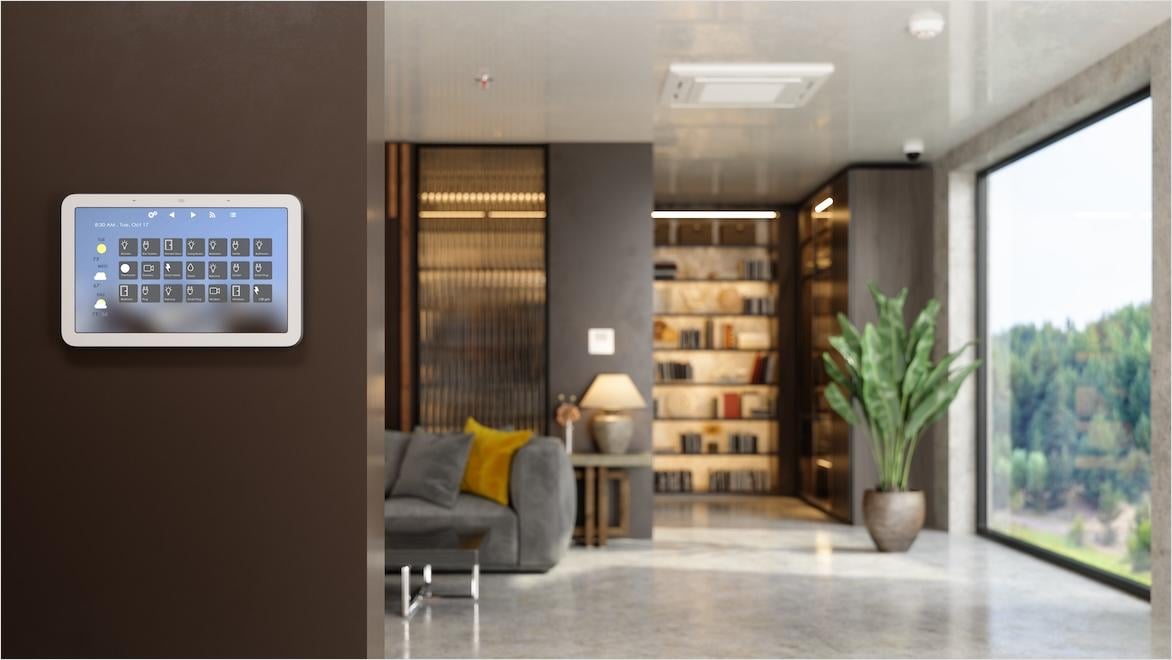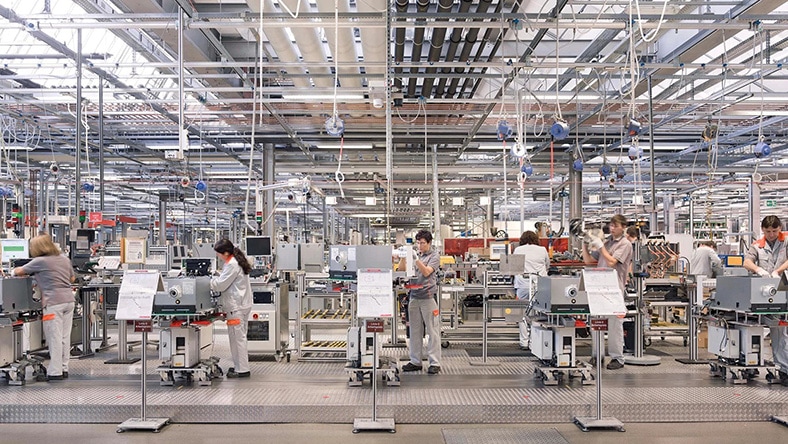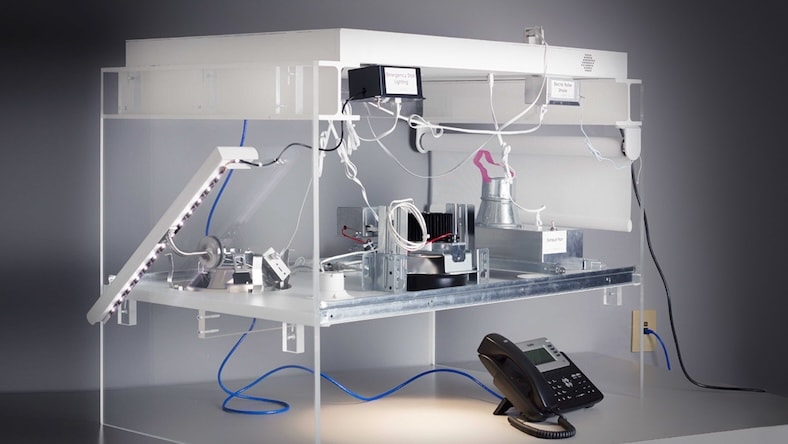& Construction

Integrated BIM tools, including Revit, AutoCAD, and Civil 3D
& Manufacturing

Professional CAD/CAM tools built on Inventor and AutoCAD
A smart building, or intelligent building, is a modern structure that uses advanced technologies to connect, analyze, and optimize its performance. Smart buildings give owners actionable insights that can improve building efficiency. They also enhance the comfort of the building’s occupants through features like variable climate control settings, automated daylight strategies, or biometric security.
Smart buildings are designed to monitor, control, and optimize aspects of operations, often using the Internet of Things (IoT) and artificial intelligence (AI). Key features of smart buildings include:
Intelligent building design minimizes energy consumption through strategies like efficient HVAC systems, optimized lighting, and intelligent power management. It uses sensors and data analysis to adjust energy usage based on occupancy and external factors.
Smart building technology integrates systems such as heating, ventilation, air conditioning, lighting, security, and access control into a centralized automation platform. This allows seamless and coordinated system control to optimize performance and comfort and reduce waste.
Smart buildings collect data from sensors, meters, and other devices. This data is analyzed to gain insight into building performance, occupant behavior, and potential areas for improvement for better decision-making.
Smart building automation includes interconnected IoT devices and sensors that enable seamless communication and data exchange among building systems and subsystems. This ensures that information flows efficiently to improve overall building operations.
Intelligent building design aims to enhance occupant comfort and productivity. Systems can adapt to individual preferences, providing personalized lighting, temperature, and other settings for a more pleasant living or working environment.
Smart building solutions incorporate advanced security measures, such as biometric access control, surveillance systems, and fire detection systems. AI-based algorithms can detect anomalies and potential threats, improving overall safety.
Predictive maintenance is a key feature of smart building technology. By monitoring equipment health and performance in real time, potential issues can be detected early, reducing downtime and repair costs.
Smart buildings promote eco-friendly practices by reducing energy consumption, optimizing resource usage, and integrating renewable energy, reducing a building’s carbon footprint and overall environmental impact. Smart building design is constantly evolving with advancements in technology. As more devices become connected and AI capabilities improve, smart building technology will continue to offer innovative solutions for sustainable, efficient, and comfortable living and working spaces.
Smart buildings allow a great degree of control over the environmental conditions of a building—for building managers, this makes it possible to enhance livability for occupants. Smart building technology helps managers monitor data from the building in real time and make changes using integrated software.
For example, heating, ventilation, and air conditioning (HVAC) settings can be changed to match temperature trends in the building and optimize thermal comfort for the occupants. Lighting systems can also be adjusted based on usage and seasonality. Smart building tech also makes it possible to review historical data to see where improvements can be made.
Smart building technology can be implemented in many types of structures, including office buildings, commercial buildings, residential buildings, hospitals, hotels, schools, airports, industrial facilities, data centers, warehouses, and more. By integrating advanced technologies such as IoT devices, sensors, data analytics, and automation, these buildings can optimize energy usage, enhance occupant experience, improve security, and help streamline operations. Smart space buildings offer personalized services, real-time monitoring, and data-driven decision making to create efficient, sustainable, and comfortable spaces.
Today, most businesses are trying to do their part to help the environment, and smart building solutions offer powerful tools. By using building systems such as lighting and heating in the most efficient manner possible, supported by accurate real-time data, companies can substantially reduce their carbon footprint. The resulting cost savings over time can be substantial, helping ensure that smart building automation is a win financially as well as environmentally.
Smart building solutions improve the efficiency, comfort, and overall performance of a structure. Key benefits include:
Smart buildings use advanced technologies to optimize energy consumption, leading to reduced utility bills and a smaller carbon footprint.
By efficiently managing energy usage and automating systems, smart buildings can lower operational costs and maintenance expenses.
Occupants of intelligent buildings can use personalized settings for lighting, temperature, and other amenities, creating a more comfortable and productive environment.
Smart buildings allow remote monitoring and control and can predict and address maintenance issues before they become problems, reducing downtime and costs.
Smart buildings can analyze space utilization data to optimize the layout and usage of rooms and facilities.
Advanced security systems and AI-based monitoring enhance smart building safety and protect against potential threats.
Some of the most important elements of smart building setups are the many sensors that measure and record useful data. These include:
These smart building sensors allow constant monitoring of room temperatures, which can be vital for different settings, from residential buildings to manufacturing environments.
Humidity sensors in smart buildings make it possible to measure relative air humidity, ensuring it’s kept at optimal levels for the situation, which can help avoid equipment rusting or limit the spread of bacteria.
Occupancy sensors detect whether a person is present in a specific space. This can then be used to automatically switch on and off lights and HVAC systems.
These can measure many different environmental factors in intelligent buildings, as well as detect levels of pollution or noise.
Light sensors provide data to daylighting systems that can optimize a building’s lighting in response to natural light conditions.
There are many smart building technologies available for various purposes. These include:
These windows can automatically adjust the amount of light they let through to match the external sunlight conditions.
The ability to automatically control heating, ventilation, and air conditioning (HVAC) systems with smart technology based on the current environment can enhance thermal comfort and save money.
In intelligent buildings such as office or residential spaces, lights that detect occupancy or changes in lighting conditions can boost health and safety as well as energy efficiency.
Eliminating the need for physical keys that can be lost or stolen, smart access control uses technology like mobile apps or biometric readers to allow access to a building or a specific area.
Powerful BIM and CAD tools for designers, engineers, and contractors, including Revit, AutoCAD, Civil 3D, Autodesk Forma, and more
Cloud software that offers powerful, easy-to-use, AI-powered tools for pre-design and schematic design. Making the right decisions in the planning phase has never been easier.
JOHNSON CONTROLS INTERNATIONAL
Image courtesy of Johnson Controls
THE VIESSMANN GROUP
Explore how one of the world’s leading heating and air-conditioning specialists uses AutoCAD and Revit for smart factory planning.
Image courtesy of Viessmann
WZMH ARCHITECTS
Image courtesy of WZMH
Smart buildings use technologies such as IoT, machine learning, and automation to optimize building performance, prioritize user experience, and cut costs.
Follow a construction COO’s journey through a long career in the industry as smart building technology has evolved.
In Glasgow, Scotland, a plan to use long-neglected canals to revamp the city’s water management with smart building solutions creates a haven for wildlife and people.
Learn how dynamic digital models can help AEC firms and owners optimize building performance, from the start of a project through ongoing maintenance.
In Grenoble, France, Schneider Electric constructed buildings that surpassed the country’s 2012 Thermal Regulation standards and set new precedents for automation efficiency.
Smart building technology uses sensors and IoT devices to collect data on aspects such as temperature, occupancy, and energy consumption. This data is sent to a central storage or cloud platform for analysis using AI and data analytics software. The resulting insights enable automation and control of building systems, including HVAC, lighting, and security, to optimize energy usage and occupant comfort.
Integration and connectivity create seamless communication between components and user-friendly interfaces allow occupants and managers to interact with the system. Continuous improvement through data-driven decisions provided by smart building technology ensures the building operates efficiently and sustainably.
Smart buildings use a combination of technologies, including IoT devices for data collection; AI and data analytics for processing information; and building automation systems for centralized control of HVAC, lighting, and security. Cloud computing stores and manages data, while connectivity protocols enable seamless communication among devices. Predictive maintenance software helps prevent equipment failures. Energy-management systems optimize resource usage, while advanced security systems enhance building safety. Occupant-tracking technologies help optimize the use of spaces, and renewable energy integration promotes sustainability. Virtual and augmented reality technologies assist in design, planning, and training within intelligent buildings.
While the terms smart building and connected building are often used interchangeably, they have distinct differences.
A smart building uses advanced technologies such as IoT devices, sensors, data analytics, and AI to optimize operations and enhance occupant experience. It focuses on automation and data-driven decision making to improve energy efficiency, security, and overall building performance.
On the other hand, a connected building emphasizes interconnectivity between building systems, enabling communication and data exchange. A connected building may integrate technologies for improved monitoring and control but may not employ advanced data analytics or automation like a smart building.
Smart building solutions are designed with sustainability in mind, using advanced technologies such as sensors, AI, and renewable energy integration to optimize energy usage and resource management. They monitor occupancy and adjust systems such as lighting and HVAC to minimize waste and reduce greenhouse gas emissions. Predictive maintenance ensures equipment efficiency, while data-driven decision making identifies areas for improvement. Intelligent buildings promote eco-friendly practices, encourage green building certifications, and integrate with smart grids to support sustainable energy consumption.
Older buildings can be retrofitted with smart building technology by adding or upgrading components such as sensors, IoT devices, and automation systems. The retrofitting process involves assessing the building’s infrastructure, upgrading the network for connectivity, and integrating sensors throughout the property to collect data. Smart building automation systems are implemented to centralize control of various systems, and data analytics and AI are used to process the collected data for optimized energy usage and proactive maintenance. With careful planning and implementation, retrofitting older buildings with smart building technology offers benefits like improved efficiency, occupant experience, and sustainability.






